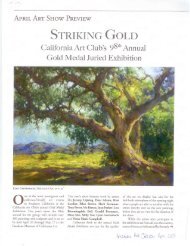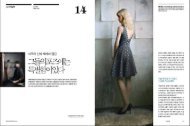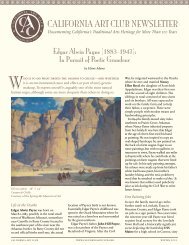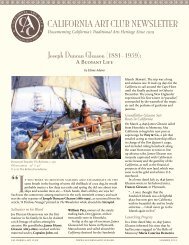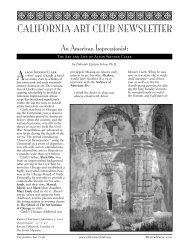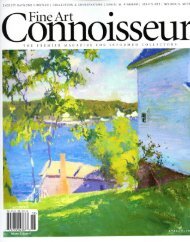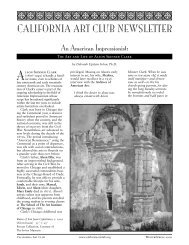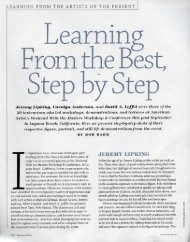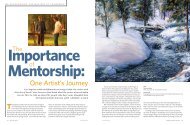Alexey Steele Featured in American Artist Workshop Magazine
Alexey Steele Featured in American Artist Workshop Magazine
Alexey Steele Featured in American Artist Workshop Magazine
You also want an ePaper? Increase the reach of your titles
YUMPU automatically turns print PDFs into web optimized ePapers that Google loves.
OPPOSITE PAGE<br />
<strong>Alexey</strong> <strong>Steele</strong> demonstrated<br />
pa<strong>in</strong>t<strong>in</strong>g techniques dur<strong>in</strong>g a<br />
workshop <strong>in</strong> his Los Angeles<br />
studio that was sponsored by<br />
the California Art Club.<br />
<strong>Alexey</strong><br />
<strong>Steele</strong>:<br />
Pursu<strong>in</strong>g Passion and a<br />
Personal Vision<br />
<strong>Alexey</strong> <strong>Steele</strong> is not the type of teacher<br />
who imposes strict guidel<strong>in</strong>es or rules<br />
on his students. Rather, he offers an<br />
encourag<strong>in</strong>g educational environment<br />
for artists to discover their own personal<br />
vision while he demonstrates his own<br />
passionate pursuit of the great artistic<br />
and cultural ideals of the past.<br />
by Michael Zakian<br />
Photos this article: Olga Vlasova and Michael Zakian
<strong>Steele</strong><br />
Stepp<strong>in</strong>g <strong>in</strong>to <strong>Alexey</strong> <strong>Steele</strong>’s studio is like enter<strong>in</strong>g<br />
a fantastic time warp. Set <strong>in</strong> a cavernous, <strong>in</strong>dustrial<br />
space south of downtown Los Angeles, his massive<br />
studio would dwarf that of most other artists. But at<br />
7,500 square feet, it is perfectly suited to both his<br />
oversized personality and his grand ambition of reviv<strong>in</strong>g the<br />
humanistic Renaissance-Baroque tradition <strong>in</strong> our own time.<br />
Filled with an amaz<strong>in</strong>g array of pa<strong>in</strong>t<strong>in</strong>gs, plaster casts,<br />
props, and artifacts, it looks and feels like an Old Master<br />
atelier transported <strong>in</strong>to the 21 st century.<br />
<strong>Steele</strong> knows the grand European tradition of pa<strong>in</strong>t<strong>in</strong>g<br />
extremely well because he experienced it firsthand. A native<br />
of Russia, he is the son of an academically tra<strong>in</strong>ed pa<strong>in</strong>ter,<br />
Leonid <strong>Steele</strong>, who is an acclaimed social realist of the Soviet<br />
School. <strong>Steele</strong> followed <strong>in</strong> his father’s footsteps and studied at<br />
the V. Surikov Moscow State Academy Art Institute before he<br />
moved with his parents to Southern California when he was<br />
23 years old. As a young artist work<strong>in</strong>g <strong>in</strong> Los Angeles, he set<br />
out to bridge two cultures and synthesize two traditions by<br />
comb<strong>in</strong><strong>in</strong>g what he learned at the Russian academy with a<br />
new appreciation of California light and color.<br />
A hallmark of <strong>Steele</strong>’s life and art is passion—a passion<br />
for pa<strong>in</strong>t<strong>in</strong>g and for promot<strong>in</strong>g the highest ideals of great culture<br />
and f<strong>in</strong>e art. He recently shared these pr<strong>in</strong>ciples <strong>in</strong> his<br />
characteristic exuberant manner dur<strong>in</strong>g a three-day workshop<br />
sponsored by the California Art Club. Rather than impose<br />
strict rules and methods, <strong>Steele</strong> served as an <strong>in</strong>spir<strong>in</strong>g guide<br />
who enthusiastically encouraged participants to pursue their<br />
own manners and styles. “Everyone has the capacity to figure<br />
out the process of pa<strong>in</strong>t<strong>in</strong>g,” he announced at the beg<strong>in</strong>n<strong>in</strong>g<br />
of the workshop. “Your m<strong>in</strong>d will give you the answers, if you<br />
ask the right questions. My job is not to give you answers. I<br />
want to help you ask the right questions.” Pa<strong>in</strong>t<strong>in</strong>g, he noted,<br />
“is simple, it follows basic logical pr<strong>in</strong>ciples. Difficulties arise<br />
when our bra<strong>in</strong>s confuse what we see.” By pos<strong>in</strong>g the right<br />
questions—and by offer<strong>in</strong>g helpful <strong>in</strong>sights—<strong>Steele</strong> created<br />
a learn<strong>in</strong>g experience dur<strong>in</strong>g which everyone ga<strong>in</strong>ed a new<br />
understand<strong>in</strong>g of their craft and of their goals as artists.<br />
Light<br />
<strong>Steele</strong> began the workshop by draw<strong>in</strong>g attention to the visual<br />
characteristics of the studio environment. “Space is your<br />
pr<strong>in</strong>cipal tool,” he stated. “It def<strong>in</strong>es the scope and range of<br />
your pa<strong>in</strong>t<strong>in</strong>g.” He expla<strong>in</strong>ed that he selected this particular<br />
location for his studio because he could add 19-foot-high<br />
skylights, which bathe the <strong>in</strong>terior with natural light. “I do<br />
not believe <strong>in</strong> artificial light,” he told the students. “It does<br />
not flicker or vibrate <strong>in</strong> the same way as natural light. I want<br />
my light to be alive.” In Southern California normal daylight<br />
can be bl<strong>in</strong>d<strong>in</strong>g and <strong>in</strong>tense. “Light needs to drop a distance<br />
so that it cools and becomes diffuse,” he expla<strong>in</strong>ed. “Sunlight<br />
is usually too strong and too hot.” When a student asked<br />
about the many baffles and scrims cover<strong>in</strong>g parts of the skylights,<br />
<strong>Steele</strong> remarked on the importance of controll<strong>in</strong>g your<br />
light. “Although I need an abundance of even light when I<br />
OPPOSITE PAGE, AbOvE And bElOw rIGhT<br />
<strong>Steele</strong>’s studio is a vast warehouse<br />
modified to suit the needs of a contemporary<br />
realist. He added skylights so<br />
that he can pa<strong>in</strong>t under filtered natural<br />
light, which he feels is more vibrant and<br />
alive than artificial light.<br />
OPPOSITE PAGE, bElOw lEfT<br />
A camera can record only a small<br />
percentage of the visual <strong>in</strong>formation<br />
seen by the human eye. <strong>Steele</strong> encouraged<br />
students to rely on a broad range<br />
of their perceptions and emotions to add<br />
fullness and life to their pa<strong>in</strong>t<strong>in</strong>gs.<br />
84 <strong>Workshop</strong> www.<strong>Artist</strong>Daily.com<br />
www.<strong>Artist</strong>Daily.com Summer 2010 85
<strong>Steele</strong><br />
work on big canvases, when I’m work<strong>in</strong>g on smaller figure<br />
studies, I close or dim down many of the skylights to create<br />
low focused light fall<strong>in</strong>g on the model. It allows me to see<br />
color better. In this way, color becomes more subtle yet more<br />
powerful. It glows.” To illustrate his po<strong>in</strong>t, he mentioned the<br />
artwork of the great 19 th -century Russian realists, such as<br />
Rep<strong>in</strong>, po<strong>in</strong>t<strong>in</strong>g out that <strong>in</strong> Russia, “the permanent overcast<br />
gives you rich color relationships.”<br />
The workshop was structured so that <strong>Steele</strong> pa<strong>in</strong>ted his<br />
demonstration and lectured on the first day. On the second and<br />
third days, participants pa<strong>in</strong>ted the same model <strong>in</strong> the same<br />
pose while the <strong>in</strong>structor offered advice and critiques. He took<br />
time to arrange the model so that there was a sensuous twist<br />
between her rib cage and pelvis. “The torso is the orig<strong>in</strong> of what<br />
we call a ‘plastic language,’ he expla<strong>in</strong>ed. “Beg<strong>in</strong> by look<strong>in</strong>g for<br />
the dynamics between the shoulders and hips, as this ma<strong>in</strong> dimensional<br />
volume of the body def<strong>in</strong>es the weight equilibrium.”<br />
He had adjusted the skylights so that the upper torso would be<br />
<strong>in</strong> shadow and the legs <strong>in</strong> full light to help participants notice<br />
subtle shifts <strong>in</strong> color and value. “Pay attention to what you see,”<br />
he advised. “A good model teaches you. What you take <strong>in</strong> visually<br />
becomes a source for your ideas.”<br />
For <strong>Steele</strong>, pa<strong>in</strong>t<strong>in</strong>g is a deeply humanistic endeavor and is<br />
essential to ma<strong>in</strong>ta<strong>in</strong><strong>in</strong>g the vitality and health of our culture.<br />
He drew attention to the model stand and talked about how<br />
the task of pa<strong>in</strong>ters differs dramatically from simple photography.<br />
“We live <strong>in</strong> a world of cameras,” he po<strong>in</strong>ted out. “Our<br />
society th<strong>in</strong>ks photographic images are the ultimate truth. But<br />
the camera can only record a very narrow spectrum of tone<br />
<strong>in</strong> either a light or a dark range, never both. It also has a very<br />
limited ability to read color. The human eye can see so much<br />
more. If a camera snaps one frame at, say, one-sixtieth of a<br />
second, it captures only a t<strong>in</strong>y part of reality. Life pa<strong>in</strong>t<strong>in</strong>g takes<br />
hours or days and <strong>in</strong>volves the full richness of human experience.<br />
Process<strong>in</strong>g such enormous amounts of <strong>in</strong>formation<br />
requires mak<strong>in</strong>g thoughtful personal choices. As an artist you<br />
have to synthesize thousands of seconds of see<strong>in</strong>g—and reflect<br />
deeply on each step of the process. That is why pa<strong>in</strong>t<strong>in</strong>g offers<br />
so much more than a snapshot.”<br />
86 <strong>Workshop</strong> www.<strong>Artist</strong>Daily.com<br />
AbOvE<br />
In his critiques, <strong>Steele</strong> cont<strong>in</strong>ually urged<br />
pa<strong>in</strong>ters to sharpen their observational<br />
skills. “If your pa<strong>in</strong>t<strong>in</strong>g does not look<br />
right,” he expla<strong>in</strong>ed, “the problem usually<br />
lies <strong>in</strong> not look<strong>in</strong>g carefully enough. Always<br />
rely on the visual <strong>in</strong>formation before<br />
you. The model is never wrong.”<br />
OPPOSITE PAGE (All)<br />
<strong>Steele</strong> pa<strong>in</strong>ted <strong>in</strong> an assertive,<br />
determ<strong>in</strong>ed stance, project<strong>in</strong>g his<br />
body’s physical energy <strong>in</strong>to his<br />
canvas. He believes that artists<br />
must <strong>in</strong>still this vitality <strong>in</strong>to their<br />
image if they want their pa<strong>in</strong>t<strong>in</strong>gs<br />
to be alive.<br />
<strong>Steele</strong>’s Materials<br />
PALette<br />
Williamsburg and Utrecht oils <strong>in</strong> the follow<strong>in</strong>g colors:<br />
n cadmium yellow medium<br />
n yellow ochre<br />
n cadmium orange<br />
n cadmium red medium<br />
n alizar<strong>in</strong> crimson<br />
n cobalt blue<br />
n cobalt turquoise<br />
n viridian<br />
n raw sienna<br />
n burnt sienna<br />
n raw umber<br />
n burnt umber<br />
n z<strong>in</strong>c white<br />
n Mars ivory black<br />
BRUSHeS<br />
n Escoda, Utrecht, and Da V<strong>in</strong>ci bristles, sizes 1 through 100<br />
n Da V<strong>in</strong>ci acrylic flats, sizes 1 through 32<br />
n Escoda kol<strong>in</strong>sky sable, size 0<br />
CANVAS<br />
n oil-primed stretched l<strong>in</strong>en or l<strong>in</strong>en board<br />
www.<strong>Artist</strong>Daily.com Summer 2010 87
<strong>Steele</strong><br />
Demonstration: Das Kapital<br />
1<br />
Step 1<br />
<strong>Steele</strong> began this demonstration<br />
by encourag<strong>in</strong>g everyone<br />
to spend time on the block-<strong>in</strong><br />
draw<strong>in</strong>g. “Use straights to def<strong>in</strong>e<br />
masses and to establish the<br />
location of your figure on your<br />
canvas,” he advised. Occasionally<br />
he will let his draw<strong>in</strong>g sit<br />
overnight so that he can reassess<br />
relationships the next day<br />
with a fresh eye.<br />
Step 2<br />
He next advocated us<strong>in</strong>g a rich<br />
middle-value color to lay <strong>in</strong> the<br />
mass of the figure. “The real<br />
beauty of the color lies <strong>in</strong> your<br />
middle-value tones,” <strong>Steele</strong> said.<br />
“Get this color right. It provides<br />
the key to the rest of your<br />
pa<strong>in</strong>t<strong>in</strong>g.”<br />
Step 3<br />
Once he had established a<br />
basic middle-value color for<br />
the figure, <strong>Steele</strong> began to<br />
model form. “Model<strong>in</strong>g <strong>in</strong>volves<br />
add<strong>in</strong>g and turn<strong>in</strong>g away,” he<br />
expla<strong>in</strong>ed. “It is an ongo<strong>in</strong>g<br />
process of lighten<strong>in</strong>g and<br />
darken<strong>in</strong>g. You only need three<br />
values to produce volume. Once<br />
you are with<strong>in</strong> the proper range,<br />
you can shape anyth<strong>in</strong>g.”<br />
Step 4<br />
“F<strong>in</strong>ish is not add<strong>in</strong>g more detail,”<br />
the artist expla<strong>in</strong>ed. “It is a further<br />
ref<strong>in</strong>ement and subdivision of<br />
what you have established on<br />
your canvas. Your goal is not to<br />
fill your pa<strong>in</strong>t<strong>in</strong>g with countless<br />
details. You want to further ref<strong>in</strong>e<br />
your large statement.”<br />
2 3<br />
88 <strong>Workshop</strong> www.<strong>Artist</strong>Daily.com<br />
4<br />
ThE cOmPlETEd dEmOnSTrATIOn:<br />
Das Kapital<br />
2010, oil, 30 x 30.<br />
Collection the artist.<br />
www.<strong>Artist</strong>Daily.com Summer 2010 89
<strong>Steele</strong><br />
<strong>Steele</strong> began his demonstration by lay<strong>in</strong>g <strong>in</strong> a broad wash<br />
of a neutral dark tone and then proceeded to block <strong>in</strong> the<br />
broad masses of the figure and bed. He had sound advice for<br />
handl<strong>in</strong>g the eccentric shape of the figure’s body: “I chose the<br />
extreme foreshorten<strong>in</strong>g of this pose to help you comb<strong>in</strong>e figure<br />
draw<strong>in</strong>g and composition,” he said to the students. “Th<strong>in</strong>k of<br />
everyth<strong>in</strong>g you see as a series of two-dimensional l<strong>in</strong>es and<br />
shapes, with a dimensionally foreshortened object always<br />
<strong>in</strong>side. Foreshorten<strong>in</strong>g is easier to understand once you realize<br />
that regardless of which angle you view an object from, part<br />
of it is always foreshortened. It is simply the relationship of<br />
objects <strong>in</strong> space to you as the viewer. One simple way to deal<br />
with foreshortened elements is to always look for and contrast<br />
them with those that are not.”<br />
As <strong>Steele</strong> worked on his <strong>in</strong>itial lay-<strong>in</strong>, a student remarked<br />
his surprise that the <strong>in</strong>structor was us<strong>in</strong>g such a large brush<br />
for the beg<strong>in</strong>n<strong>in</strong>g stages. “You can pa<strong>in</strong>t amaz<strong>in</strong>g detail<br />
with a size 30 brush and fill large areas with a size 2,” <strong>Steele</strong><br />
expla<strong>in</strong>ed. “The brush is simply a way to record your th<strong>in</strong>k<strong>in</strong>g.<br />
By stretch<strong>in</strong>g the limits of your tools, you develop your<br />
skills as a pa<strong>in</strong>ter.” The <strong>in</strong>structor encouraged everyone to<br />
f<strong>in</strong>d their own set of materials. “There is no one selection of<br />
materials that is superior to another, just as there is no one<br />
right way to capture what you see,” <strong>Steele</strong> said. “My choice of<br />
brushes and pigments is an extension of my body and works<br />
for me, but it may not work for you. Select the materials and<br />
colors you feel most comfortable with. Then explore how you<br />
can use them to solve visual problems.”<br />
Value & Color<br />
Once he f<strong>in</strong>ished the block-<strong>in</strong> of the figure and the general<br />
composition, <strong>Steele</strong> switched his attention to lay<strong>in</strong>g <strong>in</strong> color.<br />
He advised the class to mix a generous amount of a rich,<br />
middle-value flesh tone to serve as a foundation for the<br />
entire figure. “Look for this general middle-value color of the<br />
model’s sk<strong>in</strong> by f<strong>in</strong>d<strong>in</strong>g a spot somewhere between pure light<br />
and pure shadow,” the artist said. He used white, raw sienna,<br />
and alizar<strong>in</strong> crimson as a base, add<strong>in</strong>g burnt sienna, cobalt<br />
blue, and viridian to cool and adjust the color. “Take the time<br />
to get this first color right,” he advised. “The true beauty of<br />
color is <strong>in</strong> your middle-value tones. These values establish the<br />
key of your pa<strong>in</strong>t<strong>in</strong>g. It is very subjective, and everyone will<br />
see it differently. Do not fight your decisions. Embrace them<br />
as the beg<strong>in</strong>n<strong>in</strong>g of your personal style.”<br />
As <strong>Steele</strong> made the transition from lay-<strong>in</strong> to model<strong>in</strong>g, he<br />
emphasized the importance of observ<strong>in</strong>g and understand<strong>in</strong>g<br />
the range of values. “Be careful to keep your light and shadow<br />
ranges separate,” he said. “If you do that, you can go on to develop<br />
each range however you like.” After you have established<br />
a certa<strong>in</strong> tonal range, you can advance to model<strong>in</strong>g. “Model<strong>in</strong>g<br />
90 <strong>Workshop</strong> www.<strong>Artist</strong>Daily.com<br />
“everyone has the capacity<br />
to figure out the process<br />
of pa<strong>in</strong>t<strong>in</strong>g. Your m<strong>in</strong>d will<br />
give you the answers, if<br />
you ask the right questions.<br />
My job is not to give you<br />
answers. I want to help you<br />
ask the right questions.”<br />
<strong>in</strong>volves add<strong>in</strong>g and tak<strong>in</strong>g away,” the artist expla<strong>in</strong>ed. “It is<br />
an ongo<strong>in</strong>g process of lighten<strong>in</strong>g and darken<strong>in</strong>g. Once you<br />
are with<strong>in</strong> the proper tonal range, you can shape anyth<strong>in</strong>g.<br />
Remember, you need only three values to model a form: a light,<br />
a midtone, and a shadow. You can then break each value <strong>in</strong>to<br />
three smaller parts, break those parts <strong>in</strong>to smaller parts, and so<br />
on. If you are comfortable with a certa<strong>in</strong> value range, stick to<br />
that range to turn the form <strong>in</strong> space. You will f<strong>in</strong>d that you can<br />
easily shape form, and your values will be harmonious. Develop<br />
the ability to stay precisely with<strong>in</strong> your chosen range.”<br />
Keep<strong>in</strong>g your values consistent will help you make a logical<br />
transition to us<strong>in</strong>g color. “Color harmony arises from value<br />
harmony,” <strong>Steele</strong> said. “It is helpful to th<strong>in</strong>k of value as tone,<br />
just as <strong>in</strong> music. Make the midtones talk to one another, then<br />
focus on your range of lights and darks. If you add color to this<br />
consistent system of values, your colors will be <strong>in</strong> concert with<br />
one another.” In order to <strong>in</strong>troduce color successfully, an artist<br />
needs to observe how it functions with<strong>in</strong> his or her subject.<br />
<strong>Steele</strong> asked the class to look carefully at transitions. “Transitions<br />
are never just lighter or darker,” he noted. “They are also<br />
warmer or cooler—a change <strong>in</strong> temperature. Color transitions<br />
help move the eye around forms.”<br />
In order for students to master the shift from value to color<br />
on their palettes, <strong>Steele</strong> recommended they rely on different<br />
pigments for specific functions. The artist conceptually divides<br />
his palette <strong>in</strong>to a series of earth and m<strong>in</strong>eral colors, turn<strong>in</strong>g<br />
to each set to produce particular results. “Build your values<br />
with earth tones, such as ochre or umbers, to establish a tonal<br />
range,” he advised. “They are the muscle and force of your<br />
palette. Then you state and clarify your color range us<strong>in</strong>g the<br />
m<strong>in</strong>eral colors, such as the cadmiums, cobalt, and viridian.<br />
They are the viol<strong>in</strong>s that add the lyric melody.”<br />
Personal Vision<br />
On the second day of the workshop, the participants worked<br />
on their own pa<strong>in</strong>t<strong>in</strong>gs. <strong>Steele</strong> provided encouragement as<br />
OPPOSITE PAGE<br />
After absorb<strong>in</strong>g <strong>Steele</strong>’s<br />
passion and dedication to<br />
pa<strong>in</strong>t<strong>in</strong>g, students worked<br />
on their own canvases with<br />
a focused <strong>in</strong>tensity.<br />
AbOvE<br />
<strong>Steele</strong> emphasized the fact that figure pa<strong>in</strong>t<strong>in</strong>g<br />
“is always a personal <strong>in</strong>terpretation based on<br />
your <strong>in</strong>dividual po<strong>in</strong>t of view. You are your ma<strong>in</strong><br />
tool. If you have confidence <strong>in</strong> your decisions,<br />
your art will be stronger.”<br />
each student began to establish his or her composition and<br />
color key. His suggestions for improvement were always<br />
<strong>in</strong>sightful. To assist people who struggled with their draw<strong>in</strong>g,<br />
he said, “Check your angles with your brush. And reduce<br />
your subject to straight l<strong>in</strong>es; it helps you build shapes correctly.<br />
Also, use cross-references. Employ as many systems<br />
of check<strong>in</strong>g and execution as possible, such as diagonals and<br />
plumb l<strong>in</strong>es—cross-checked by th<strong>in</strong>k<strong>in</strong>g of a form <strong>in</strong> terms<br />
of a block or cyl<strong>in</strong>der—to help you accurately capture your<br />
composition on canvas.”<br />
As an <strong>in</strong>structor, <strong>Steele</strong> has a remarkable and rare<br />
capacity to focus on improv<strong>in</strong>g each student’s own vision<br />
and style, rather than impos<strong>in</strong>g his own method. When one<br />
pa<strong>in</strong>ter remarked that she thought her color range might<br />
be too blue, he advised her to explore it, rather than change<br />
it. “Each <strong>in</strong>dividual <strong>in</strong>terprets color differently,” he said. “As<br />
you cont<strong>in</strong>ue to model your forms, simply stay <strong>in</strong> your established<br />
value range.” By show<strong>in</strong>g her how to work with<strong>in</strong><br />
www.<strong>Artist</strong>Daily.com Summer 2010 91
<strong>Steele</strong><br />
About the <strong>Artist</strong><br />
<strong>Alexey</strong> <strong>Steele</strong> was born <strong>in</strong> Kiev, Ukra<strong>in</strong>e, <strong>in</strong> 1967 and<br />
began his art tra<strong>in</strong><strong>in</strong>g at an early age <strong>in</strong> the studio of<br />
his father, Leonid <strong>Steele</strong>. He furthered his professional<br />
education at the V. Surikov Moscow State Academy Art<br />
Institute under IIya Glazunov. In 1990, <strong>Steele</strong> moved to<br />
Los Angeles, where he has established a career pa<strong>in</strong>t<strong>in</strong>g<br />
large-scale figurative works, commissioned portraits,<br />
and ple<strong>in</strong> air landscapes, <strong>in</strong> addition to advocat<strong>in</strong>g f<strong>in</strong>e<br />
art’s greater role <strong>in</strong> everyday society. He is a signature<br />
artist member of the California Art Club and the founder<br />
of Classical Underground, a unique platform showcas<strong>in</strong>g<br />
the <strong>in</strong>terconnection of classical forms <strong>in</strong> music and visual<br />
art. He has exhibited at the Fleicher Museum, <strong>in</strong> Scottsdale,<br />
Arizona; Bowers Museum, <strong>in</strong> Santa Ana, California;<br />
Natural History Museum of Los Angeles County; and<br />
the Frederick R. Weisman Museum of Art at Pepperd<strong>in</strong>e<br />
University, <strong>in</strong> Malibu, California. Articles on his work have<br />
appeared <strong>in</strong> various publications, <strong>in</strong>clud<strong>in</strong>g <strong>American</strong> <strong>Artist</strong>,<br />
Southwest Art, F<strong>in</strong>e Art Connoisseur, Gramophone,<br />
and the Los Angeles Times. In 2009 he received both the<br />
Artemis Award, <strong>in</strong> Athens, Greece, and the Gusi Peace<br />
Prize, <strong>in</strong> the Philipp<strong>in</strong>es. Most recently he became the<br />
founder of www.novorealism.com, argu<strong>in</strong>g for a new role<br />
for contemporary realism with<strong>in</strong> modern culture. He is<br />
represented by <strong>American</strong> Legacy F<strong>in</strong>e Arts, <strong>in</strong> Pasadena,<br />
California. For more <strong>in</strong>formation on <strong>Steele</strong>, visit his<br />
website at www.alexeysteele.com.<br />
AbOvE lEfT<br />
<strong>Steele</strong> urged everyone to be fully<br />
conscious of every decision. “Even<br />
Rembrandt and Michelangelo made<br />
mistakes,” he said. “But there are<br />
no real mistakes. It is all part of the<br />
process. You ga<strong>in</strong> knowledge with<br />
each brushstroke.”<br />
AbOvE<br />
<strong>Steele</strong> has the ability to work with artists<br />
of all levels of ability—and br<strong>in</strong>g out their<br />
best. He encouraged everyone to pay<br />
attention to the qualities of the image evolv<strong>in</strong>g<br />
on their canvas. “Everyone’s personal<br />
approach is unique and forms the basis of<br />
his or her <strong>in</strong>dividual style,” he expla<strong>in</strong>ed.<br />
her chosen color key, <strong>Steele</strong> helped her produce a f<strong>in</strong>e figure<br />
study dist<strong>in</strong>guished by a slightly cooler tonality. “No two<br />
artists see the world exactly alike,” he expla<strong>in</strong>ed. “Rembrandt<br />
perceived reality <strong>in</strong> low light with dark shadows and lost<br />
edges. Egon Schiele saw everyth<strong>in</strong>g as clear volumes def<strong>in</strong>ed<br />
by hard, razor-sharp l<strong>in</strong>es. Both artists produced powerful<br />
render<strong>in</strong>gs of form. Neither view is right or wrong. That is<br />
the beauty of a personal vision.”<br />
When a student asked how to handle edges, <strong>Steele</strong><br />
immediately responded: “Edges arise directly from the<br />
successful render<strong>in</strong>g of form. Strict rules for hard or soft<br />
edges can become shallow tricks that lead to formulaic<br />
pa<strong>in</strong>t<strong>in</strong>gs. Focus on model<strong>in</strong>g form first. If you are look<strong>in</strong>g<br />
at your subject closely and as a whole, the correct edges will<br />
follow. Do not th<strong>in</strong>k of draw<strong>in</strong>g and pa<strong>in</strong>t<strong>in</strong>g as separate<br />
processes. Remember that with every brushstroke, your job<br />
is to produce form. Great artists such as Velázquez were able<br />
to capture correct color, value, and form <strong>in</strong> each brushstroke.<br />
This <strong>in</strong>tegral unity is what separates great art from good art.”<br />
Dur<strong>in</strong>g breaks, <strong>Steele</strong> engaged the class <strong>in</strong> lively discussions<br />
of art and its function <strong>in</strong> society. He showed students<br />
his sketches for new, large multifigure works that drew<br />
upon his studies from life. He even brought out work he<br />
did as a teenage art student <strong>in</strong> Moscow, as well as a phenomenal<br />
academic draw<strong>in</strong>g created by his father at the<br />
Rep<strong>in</strong> Art Institute, <strong>in</strong> St. Petersburg (then Len<strong>in</strong>grad),<br />
Russia. In between critiques, the <strong>in</strong>structor returned to<br />
92 <strong>Workshop</strong> www.<strong>Artist</strong>Daily.com<br />
AbOvE<br />
<strong>Steele</strong> represents a cont<strong>in</strong>uation and<br />
a revival of the European academic<br />
tradition. He proudly shared a remarkably<br />
accomplished figure study drawn<br />
by his father while he was a student.<br />
his easel to add f<strong>in</strong>ish<strong>in</strong>g<br />
touches to his own pa<strong>in</strong>t<strong>in</strong>g.<br />
Although his demonstration<br />
was essentially complete, he<br />
felt there were a few areas that<br />
could use further work. Someone asked, “How do you know<br />
a pa<strong>in</strong>t<strong>in</strong>g is complete?” <strong>Steele</strong> answered, “F<strong>in</strong>ish is not a<br />
question of putt<strong>in</strong>g more <strong>in</strong>. It is just a matter of <strong>in</strong>creas<strong>in</strong>g<br />
ref<strong>in</strong>ement and formulat<strong>in</strong>g your choices. As you work, you<br />
are further break<strong>in</strong>g down value ranges. It’s not necessarily<br />
about add<strong>in</strong>g more detail but rather about mak<strong>in</strong>g f<strong>in</strong>er and<br />
subtler subdivisions of tone. I can f<strong>in</strong>ish a pa<strong>in</strong>t<strong>in</strong>g <strong>in</strong> an<br />
hour, a day, or a week. It becomes a question of how much<br />
you want to say. But even when produc<strong>in</strong>g a large pa<strong>in</strong>t<strong>in</strong>g<br />
over months or years, your ultimate goal should be to reta<strong>in</strong><br />
the freshness of the quick study.”<br />
<strong>Steele</strong> is able to ma<strong>in</strong>ta<strong>in</strong> pictorial freshness by always<br />
keep<strong>in</strong>g his vision and image full of life. “If it is not alive,<br />
then you have a dead picture,” he declared. “The key to any<br />
work of art is vitality. Some of my classical musician friends<br />
call this quality forza. This Italian term refers to a comb<strong>in</strong>ation<br />
of strength and dar<strong>in</strong>g, power and precision. To achieve<br />
this, a pa<strong>in</strong>ter must coord<strong>in</strong>ate his eye, m<strong>in</strong>d, and hand <strong>in</strong><br />
complete unity to make form, value, and color with every<br />
stroke. In powerful and fluid pa<strong>in</strong>t<strong>in</strong>gs these connections are<br />
immediate. In tentative pa<strong>in</strong>t<strong>in</strong>gs they are slow and hesitant.”<br />
For <strong>Steele</strong>, art is a passionate battle. It is not only a<br />
struggle to render your subject well but also an opportunity<br />
to perfect your own sensibility and life. “It’s like Zen,” he<br />
said, “a lifelong pursuit of simplicities.” He drew an analogy<br />
to Bushido, the Japanese philosophy of the samurai warrior.<br />
“Like Bushido, art is a personal quest,” he stated. “You are<br />
ref<strong>in</strong><strong>in</strong>g yourself. The artist is <strong>in</strong> a position of ultimate power.<br />
Soldiers use lethal force to kill. Pa<strong>in</strong>ters use vital force to recreate<br />
life itself, and that is art. Focus on the positive qualities<br />
of life and you will grow as an artist.”<br />
The workshop concluded with a group critique dur<strong>in</strong>g<br />
which everyone reviewed their progress and talked about<br />
what they had learned. <strong>Steele</strong> encouraged everyone to<br />
cont<strong>in</strong>ue their practice beyond the workshop, particularly<br />
through draw<strong>in</strong>g, as there are “no shortcuts.” With his<br />
<strong>in</strong>fectious enthusiasm, he rem<strong>in</strong>ded everyone to pursue an<br />
<strong>in</strong>dividual path. “Good pa<strong>in</strong>t<strong>in</strong>g is never about follow<strong>in</strong>g<br />
rules,” he stated. “In a way, it is about not know<strong>in</strong>g what you<br />
are do<strong>in</strong>g—so you can figure it out as you go. Art is a mental<br />
process. Your hand will automatically respond to what your<br />
m<strong>in</strong>d is focused upon. Your tra<strong>in</strong><strong>in</strong>g is done best by sett<strong>in</strong>g<br />
specific tasks and solv<strong>in</strong>g the problems yourself.” n<br />
Michael Zakian is the director of the Frederick R. Weisman Museum<br />
of Art at Pepperd<strong>in</strong>e University, <strong>in</strong> Malibu, California, and is an art<br />
historian and artist.<br />
www.<strong>Artist</strong>Daily.com Repr<strong>in</strong>ted from <strong>Workshop</strong> Summer: Copyright © 2010 by Interweave Press, LLC. All rights reserved.<br />
Summer 2010 93
<strong>Steele</strong><br />
<strong>Steele</strong>’s Work<br />
AbOvE<br />
Golden Ra<strong>in</strong><br />
2010, oil, 8 x 6. Private<br />
collection.<br />
rIGhT<br />
Beggar, San Miguel de<br />
Allende<br />
2010, oil, 16 x 12. Courtesy<br />
<strong>American</strong> Legacy F<strong>in</strong>e<br />
Arts, Pasadena, California.<br />
AbOvE<br />
Fire and Water<br />
2009, oil, 60 x 36.<br />
Private collection.<br />
lEfT<br />
Red<br />
2008, oil, 12 x 9.<br />
Private collection.<br />
94 <strong>Workshop</strong> www.<strong>Artist</strong>Daily.com<br />
AbOvE<br />
Street Sellers,<br />
San Miguel de<br />
Allende<br />
2010, oil, 16 x 12.<br />
Courtesy <strong>American</strong><br />
Legacy F<strong>in</strong>e Arts,<br />
Pasadena, California.<br />
rIGhT<br />
Photographer:<br />
Lemuel<br />
2008, oil, 60 x 36.<br />
Collection the artist.<br />
lEfT<br />
Romy<br />
2009, oil, 30 x 60.<br />
Private collection.<br />
www.<strong>Artist</strong>Daily.com Summer 2010 95



